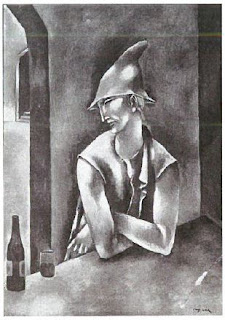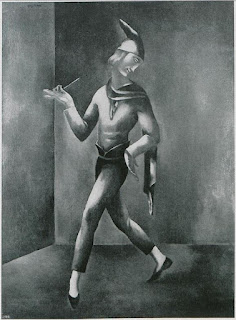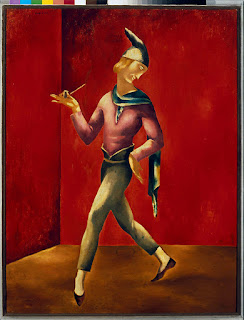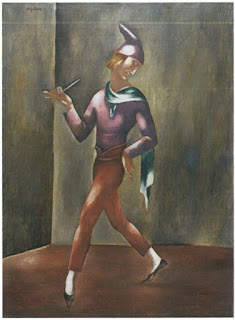by Agnieszka Yass-Alsston
[Editor’s note: This is an article released in two parts on the work of Eugeniusz Zak. The author, Agnieszka Yass-Alston, is an art historian and provenance researcher who specializes in the fate of artistic assets of Jewish art collectors in Krakow and the fate of the “oeuvre” of Jewish artists of the “École de Paris.“]
During the Annual Salon in Warsaw (1919 – 1920), together with Young Acrobat Zak showed one more picture titled Przy kieliszku (By a glass) (Fig. 6), which became a prototype for richer executions of paintings like In der Weinsture (Fig. 7) also known as Dans le cabaret (W winiarni, Pijak, Buevur) (Fig. 8 and 10). Figure 11 [see list of works below] is the first execution of the representation after the picture Przy kieliszku, when Zak paints with a darker palette of hues of lower value, mostly subdued, and heavy. In these first versions there is a noticeable lack of light’s vibrancy, as shown in the later versions like Figure 9, Dans le cabaret, where there is more contrast brought by light that illuminates the higher value of hues. It is perfectly seen in the foreground: the brightened fragment of the table and in the dress, face, and hat of the sitting male figure. The radiance of the light on the man is juxtaposed against the purple background of the wall creating a defined contrast if compared with the earlier version, where the red wall is smeared with grimy gray smudges.
 |
| Fig. 6 |
 |
| Fig. 7 |
The other example of the same approach to the execution of colors and light is Le Danseur (Tancerz, Pajac). In the earlier version of The Dancer, currently in the Warsaw National Museum (Fig. 14), purer colors are used, but they do not create the dramatic light vibration as in the later version formerly in Robert de Rothschild’s collection plundered by agents of the Einsatzstab Reichsleiter Rosenberg (ERR) in German-occupied France. There is also present this very characteristic shift from fragmentary smudging in the background to the use of lower value hues that Zak continued within this later singular figurative compositions throughout 1923 and later on, which he developed further into richer paint texture.
 |
| Fig. 8 |
 |
| Fig. 9 |
 |
| Fig. 10 |
 |
| Fig. 11 |
With respect to the provenance issue within Zak’s artistic development, but also wrongly reading historical sources and references, Barbara Brus-Malinowska made a crucial mistake regarding the provenance of Tancerz. In her catalogue Eugeniusz Zak (1884-1926) (Warsaw 2004), she wrote that Tancerz (Pajac, Pierrot), 1921 (p. 126, cat nr 136), presently in NMW inv. No. MPW 820 (Fig. 14), was exhibited in Galerie Bing, Paris 1926 kat poz. 30 and in Garliński’s Salon, Warsaw1926, kat poz 20. Additionally, she mentioned in the picture’s bibliography the book by Maximilien Gauthier Les artistes juifs Eugѐne Zak (1884 – 1926), Paris [193-], illustration 5 (page not numbered), where Baron Robert de Rothschild is mentioned as the owner of the painting (according to Gauthier’s book he owned Dans le Cabaret too).
 |
| Fig. 12 |
The exhibition of Zak’s artworks in Garliński’s Salon opened on March 10th, 1926 and was organized by the Rytm artists whom independently formed the exhibition in the Galerie Bing, Paris (March 20 – April 10, 1926). This fact excludes Tancerz from participation in the French exhibit. Garliński’s catalogue indicates that at that time Tancerz belonged to Marian Szpilfogel, who was killed during the Holocaust and his survivor daughter offered the painting to the National Museum in Warsaw. The exhibition of Zak’s artworks at Galerie Bing included paintings owned by Jadwiga Zak, the artist’s widow, where Le Danseur was presented. Before May 1931, Le Danseur was sold to Robert de Rothschild and was plundered by the infamous Einsatzstab Reichsleiter Rosenberg. (Figs. 15 and 16).
In conclusion, with respect to the sensational appearance on the market of Mann mit blauer Mütze, the provenance of the painting provided by Ketterer Kunst notes that the artwork comes from a private collection located in southern Germany. Unfortunately, there are no further details. It is regrettable that within two generations the history of this painting has been lost. The picture has not been linked so far to any pre-war collection, and has not been registered as stolen property during WWII. It could have been exhibited in Köln, Germany in 1925 at the S. Salz Kunsthandlung, where on October 25, 1925, Zak’s solo exhibit was held there. S. Salz was also an owner of a few Zak’s paintings including Le Buveur and Kobieta z kwiatem (present whereabouts unknown). Based upon a stylistic analysis, the picture was painted before 1923, most likely in 1922. Hopefully, a new owner will take on the moral responsibility and through inquisitive research figure out the detailed provenance of Mann mit blauer Mütze. Optimistically, the other paintings Jeune homme au bonnet blanc and Jeune homme au bonnet brun will resurface one day.
 |
| Fig. 13 |
 |
| Fig. 14 |
 |
| Fig. 15
|
 |
| Fig. 16 |
List of illustrations:
Figure 6 : Eugeniusz Zak, Przy Kieliszku (oil on canvas 1918/1919), illustration from La Renaissance, nr 11, 1926;
Figure 7 : Eugeniusz Zak, In der Weinsture (oil on canvas, 1922), illustration from Deutsche Kunst und Dekoration, vol. 53, 1923/1924;
Figure 8: Eugeniusz Zak, Dans le cabaret, (oil on canvas, 1922), illustration from Maximilien Gauthier, Les artistes juifs Eugѐn Zak (1884 – 1926), Paris [193-];
Figure 9 : Eugeniusz Zak, Dans le cabaret, (oil on canvas 99 x 78.5 cm., 1922), former collection of Robert de Rothschild, plundered by the ERR in Paris; 1994 Christie’s NY, 1996 Marek Mielniczuk) lastly in the collection of the late Tom Podl, Seattle, USA;
Figure 10: Eugeniusz Zak, Pijak (Buveur), illustration from Stefania Zachorska, Eugeniusz Zak (1884 – 1926), Warszawa, 1927;
Figure 11 : Eugeniusz Zak, Dans la cabaret (oil on canvas 99.5 x 79 cm., 1920) presently private collection, before in Wojciech Fibak’s collection;
Figure 12: Eugeniusz Zak, Der Pfeifenraucher, (oil on canvas, 1922), illustration from Deutsche Kunst und Dekoration, vol. 53, 1923/24;
Figure 13: Eugeniusz Zak, Tancerz (Danseur), illustration from Stafania Zahorska, Eugeniusz Zak (1884 – 1926), Warszawa, 1927;
Figure 14: Eugeniusz Zak, Tancerz (Pajac), Pierrot, (oil on canvas 113 x 86 cm., 1921) inv. nr MPW 820 National Museum Warsaw, former collection of Marian and Julia Szpilfogel, the gift of Szpilfogel’s daughter, Halina Cetnarowicz after the WW2 to the Museum;
Figure 15: Eugeniusz Zak, Le Danseur, (oil on canvas, c. 1922), illustration from Maximilien Gauthier, Les artistes juifs Eugѐn Zak (1884 – 1926), Paris [193-];
Figure 16: Eugeniusz Zak, Le Danseur (oil on canvas, 116 x 86 cm., c 1922), former collection of Robert de Rothschild, plundered by the ERR in Paris; lastly in a private collection, Switzerland.
Selective bibliography:
Barabara Brus-Malinowska, Eugeniusz Zak (1884 – 1926), Muzeum Narodowe Warszawa, 2004;
Eugeniusz Zak. Wystawa Pośmiertna, 1926; Salon Cz. Garlińskiego, Warszawa;
Exposition Rétrospective Eugѐne Zak (1884 – 1926), 1926; Galerie Marcel Bernheim, Paris;
Maximilien Gauthier, Les artistes juifs Eugѐn Zak (1884 – 1926), Paris [193-];
Zygmunt St. Klingsland, W dziesiątą rocznicę śmierci Zaka, Wiadomości Literackie, nr 42, 1936, p. 8;
H. R., Zu den Arbeiten von Eugen Zak, Deutsche Kunst und Dekoration, vol 53, 1923/1924, pp.: 130 – 134;
H. R., Ewige Romantik, Deutsche Kunst und Dekoration, vol 56, 1925, pp.: 2 – 12;
Heinrich Ritter, Eugen Zak, Deutsche Kunst und Dekoration, vol 50, 1922, pp.: 226 – 228;
Mieczysław Sterling, Eugeniusz Zak (1884 – 1926), Sztuki Piękne, vol. 12, 1925/1926, pp.: 494 – 501;
Mieczysław Wallis, Eugenisz Zak, [in:] Sztuka Polska Dwudziestolecia. Wybór pism z lat 1921 – 1957, Warszawa 1959, pp.: 109 – 117;
Stefania Zahorska, Eugenisz Zak (1884 – 1926), Warszawa, 1927;
Stefania Zahorska, Ostatni Interwiew, Sztuki Piękne, vol. 12, 1925/1926, pp.: 502 – 504.





